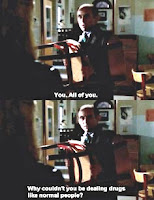Literature can provide insights into the culture and historical time period in which that literature was produced.
Years ago, my mother told me that during an exam on the nineteenth century, she realized, rather to her surprise, how much she already knew due to reading Jane Austen, one of her favorite authors. She didn’t set out to learn the information. It arrived unconsciously as part of her preferred form of entertainment.
These kinds of insights can be taken too far, of course, mostly when theorists insist on reading backwards into a piece of literature their personal pet ideologies.
For those readers who, as C.S. Lewis would say, prefer to “receive” rather than “use,” diving into a genre can expose readers and viewers to an entire lifestyle and way of thinking that seems entirely familiar while offering the rewards of new and different experiences.
To paraphrase Lewis, we “become a thousand men and yet remain [ourselves].” The following Conversations with a Translator began several years ago when I began my first major exploration of manga series.
The posts range from 2013 to 2021 (they are not strictly chronological, so a single post may reference manga and anime selections from 2013 and 2021). The posts will delve into various aspects of Japanese culture, starting with Japanese high schools. Surviving high school is a popular motif in all literature. Are these high schools a distillation of concepts/experiences? How universal are they? How individual?
Kate: I’m reading the manga series Mars, a 15-volume set written by Fuyumi Soryo. The series is your basic high school romance set in Japan. The houses/businesses/etc. are all Japanese in style as are the names.
Yet I’ve started to ponder the series’ realism. For one, the teen characters have an amazing amount of freedom. American novels would present this circumstance as utterly unrealistic. Teens must be monitored! How realistic is this lack of supervision?

That’s why the transfer student who shows up halfway through the school year is such a big deal. It suggests a complex chain of unfortunate circumstances. High schools in Japan operate under an open enrollment system. A student can matriculate at any school in the country if there’s an open spot and they can pass the entrance exam. Good Morning Call (Netflix) begins when Nao moves to Tokyo to attend high school and “accidentally” ends up sharing an apartment with Hisashi, the most popular guy in school.
Many of the teen characters in Durarara!! (Netflix Funimation) are transplants from outside Tokyo who live on their own while attending high school. That does make it easier for them to get caught up in the crazy goings-on in Ikebukuro.
In Super Cub (Funimation), Beyond the Boundary (HIDIVE), and March Comes in like a Lion (Netflix Crunchyroll), the main characters live alone in their own apartments. In their cases, they would probably be classified as emancipated minors.
There is also more self-government and more student-directed activities in Japanese high schools.
On the other hand, the lack of an omnipresent testing regime and fewer constraints outside of high school can make the American teenage experience seem like a wonderland of freedom. Most Japanese won’t get a driver’s license until their twenties (if at all).
 |
| Anne-Gilbert! |
Plots vary a great deal in high school manga. The plot of Mars is relatively realistic in that it involves neither a conspiracy (Denegeki Daisy) nor a girl-in-disguise in a school full of boys (Hana-Kimi). It also doesn’t have a supernatural component, as in Black Bird. And it is lacking the dog-eat-dog underlying tone of Caste Heaven.
Yet for a contemporary plot, Mars contains little talk of drugs though lots of talk about dating. At one point, Kira is pressured to sleep with Rei. (She eventually decides to.) So, on the one hand, Mars is not much like American plots. On the other hand, it is very much like them! What are “typical” plots for high school manga?
Bullying is a chronic problem. Incompetent teachers just putting in the time aren’t unheard of either. Which is why most students who want to get into a “good” university spend hours every day at cram schools, no matter how smart they are.
A popular genre of teen romantic comedy has a poor student winning a scholarship to an exclusive high school populated by rich snobs, and winning the heart of BMOC. The live-action television series The Story of Yamada Taro cleverly turns this formula upside down: the poor girl falls for the young prince, who turns out to be poorer than she is.
Another plot complication that crops up is English, the bane of every student in Japan. Given the demands of the test-dependent “escalator” system, doing true study abroad is a near impossibility. Being able to spend enough time abroad in order to master English and not fall off that escalator is a sure sign of privilege (or indifference).
A funny twist on this in Strawberry Marshmallow (HIDIVE) has a girl from England desperately trying to hide the fact that she grew up in Japan and can’t speak English any better than her classmates.
Kate: Stumbles over language are always potentially humorous! I encountered a scene in Hana-Kimi (above) where the Japanese-American student who gets herself accepted to a Japanese boys’ school (without her parents finding out!) does poorly on English exams. All that grammar!
In all honesty, I expected more such plot points in Mars. I was a little taken aback by how recognizable I found many classroom scenes. The teachers behaved exactly the same way as American teachers (one of them throws chalk!).
And I had to wonder, are high schools in manga “true” Japanese high schools? Or are they a crystallization of everyone’s idea of high school? Is Japanese culture not exactly the way it is portrayed in Salon.com articles (students bowing when the teacher enters the room)?
Rich kids in manga invariably live in gigantic mansions (with butlers and maids) that don’t exist anywhere in Japan. Okay, I’m sure there are mansions in Japan, and perhaps some of them have butlers and maids. But I’d expect most mansions, like the most exclusive, private schools, to be managed quite conservatively.
The flip side of this genre has a rich kid (or teacher) ending up at a reform school at the bottom end of the scale, no more realistically depicted (i.e., in dystopian terms) than the exclusive schools at the top of the scale. A good example is Gokusen, that has Kumiko, the granddaughter of a yakuza kingpin, becoming a teacher at such a school.
She has to keep the school board from finding out she’s a yakuza princess while not letting on she can be tougher and meaner than any of her students. She also has a bad habit of cussing like a yakuza when she’s stressed out.
 |
| The reality-unreality of Buffy. |
CSI: Las Vegas, for example, sorta, kinda tried to stay pinned to reality, though it still takes great dramatic license; CSI: Miami was pure, eye-rolling fantasy. NCIS somewhat approximates the real world; NCIS: Los Angeles is literally and figuratively in La La Land.
This pretty much has nothing to do with the entertainment value (though as with CSI: Miami, the lack of verisimilitude can stretch suspension of disbelief to the breaking point).
Kate: The comparison of crime shows to high school dramas makes a lot of sense. I think my “huh?” response is rooted in my perception of Japanese high schools as more “other” and interesting than American high schools—why not take advantage of that?! But of course, that perception is easily reversed!






No comments:
Post a Comment